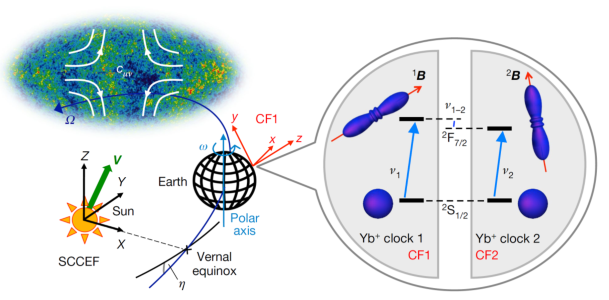Tests of fundamental symmetries and
new physics searches
The past two decades have been a transformational era for atomic, molecular, and optical (AMO) physics, due to extraordinary accomplishments in the control of matter and light. Experimental breakthroughs, including laser cooling and trapping of atoms, attainment of Bose-Einstein condensation, optical frequency combs, and quantum control— the subject of Nobel Prizes in Physics in 1997, 2001, 2005, 2012, and 2022 —have led to widespread availability of ultracold ions, atoms, and molecules, subject to precise interrogation and control. Revolutionary developments on several fronts have been made possible by these advances, aided by improvements in precision time and frequency metrology, measurement techniques such as atomic magnetometry and interferometry, and first-principles atomic and molecular theory. These advances brought forth a plethora of new AMO applications, including novel tests of the fundamental laws of physics.
Research highlights
Opportunities for Fundamental Physics Research with
Radioactive Molecules

Molecules containing short-lived, radioactive nuclei are uniquely positioned to enable a wide range of scientific discoveries in the areas of fundamental symmetries, astrophysics, nuclear structure, and chemistry. Recent advances in the ability to create, cool, and control complex molecules down to the quantum level, along with recent and upcoming advances in radioactive species production at several facilities around the world, create a compelling opportunity to coordinate and combine these efforts to bring precision measurement and control to molecules containing extreme nuclei.
In this manuscript, we review the scientific case for studying radioactive molecules, discuss recent atomic, molecular, nuclear, astrophysical, and chemical advances which provide the foundation for their study, describe the facilities where these species are and will be produced, and provide an outlook for the future of this nascent field.
Opportunities for Fundamental Physics Research with Radioactive Molecules, Gordon Arrowsmith-Kron et al., arXiv:2302.02165, in press, Reports on Progress in Physics (2024).
Optical clock comparison for Lorentz symmetry testing
The principle of relativity requires that all descriptions of nature are covariant under Lorentz transformations; that is, the laws of physics stay the same when transforming from one inertial reference frame to another. Consequently, the outcome of any experiment must be independent of the velocity and orientation of the inertial frame in which it is performed. Questioning basic assumptions about the structure of space and time has greatly enhanced our understanding of nature. Modern tests of Einstein’s theory of relativity try to measure so-far-undetected violations of Lorentz symmetry; accurately comparing the frequencies of optical clocks is a promising route to further improving such tests. Here we experimentally demonstrate agreement between two single-ion optical clocks at the 10−18 level, directly validating their uncertainty budgets, over a six-month comparison period. The ytterbium ions of the two clocks are confined in separate ion traps with quantization axes aligned along non-parallel directions. Hypothetical Lorentz symmetry violations would lead to periodic modulations of the frequency offset as the Earth rotates and orbits the Sun.
From the absence of such modulations at the 10−19 level we deduce stringent limits of the order of 10−21 on Lorentz symmetry violation parameters for electrons, improving previous limits by two orders of magnitude. Such levels of precision will be essential for low-energy tests of future quantum gravity theories describing dynamics at the Planck scale, which are expected to predict the magnitude of residual symmetry violations.

Testing Lorentz symmetry with two earthbound optical Yb+ clocks
Optical clock comparison for Lorentz symmetry testing, Christian Sanner, Nils Huntemann, Richard Lange, Christian Tamm, Ekkehard Peik, Marianna S. Safronova, Sergey G. Porsev, Nature 567, 204 (2019).
Review: Search for new physics with atoms and molecules
This article reviews recent developments in tests of fundamental physics using atoms and molecules, including the subjects of parity violation, searches for permanent electric dipole moments, tests of the CPT theorem and Lorentz symmetry, searches for spatiotemporal variation of fundamental constants, tests of quantum electrodynamics, tests of general relativity and the equivalence principle, searches for dark matter, dark energy, and extra forces, and tests of the spin-statistics theorem. Key results are presented in the context of potential new physics and in the broader context of similar investigations in other fields. Ongoing and future experiments of the next decade are discussed.
Search for new physics with atoms and molecules, M. S. Safronova, D. Budker, D. DeMille, Derek F. Jackson-Kimball, A. Derevianko, and Charles W. Clark, Rev. Mod. Phys. 90, 025008 (2018).
Other relevant recent publications
- Terrestrial Very-Long-Baseline Atom Interferometry: Workshop Summary, Sven Abend at al., AVS Quantum Sci. 6, 024701 (2024).
- Quantum Sensors for High Energy Physics, Aaron Chou et al., arXiv:2311.01930 (2023).
- Tests of Fundamental Physics, M. S. Safronova, Springer Handbook of Atomic, Molecular and Optical Physics (2nd ed.), Chapter 32, edited by Gordon W. F. Drake and Shaun Steven (2023).
- Electric dipole moments and the search for new physics, Ricardo Alarcon et al., arXiv:2203.08103 (2022).
- Snowmass 2021: Quantum Sensors for HEP Science – Interferometers, Mechanics, Traps, and Clocks, Oliver Buchmueller, Daniel Carney, Thomas Cecil, John Ellis, R. F. Garcia Ruiz, Andrew A. Geraci, David Hanneke, Jason Hogan, Nicholas R. Hutzler, Andrew Jayich, Shimon Kolkowitz, Gavin W. Morley, Holger Muller, Zachary Pagel, Christian Panda, Marianna S. Safronova, arXiv:2203.07250 (2022).
- Cold Atoms in Space: Community Workshop Summary and Proposed Road-Map, Ivan Alonso et al., EPJ Quantum Technol. 9, 30 (2022).
- Fundamental Physics with a State-of-the-Art Optical Clock in Space, Andrei Derevianko, Kurt Gibble, Leo Hollberg, Nathan R. Newbury, Chris Oates, Marianna S. Safronova, Laura C. Sinclair, Nan Yu, Quantum Sci. Technol. 7, 044002 (2022).
- Measuring the stability of fundamental constants with a network of clocks, G. Barontini at al., EPJ Quantum Technology 9, 12 (2022).
- Quantum technologies and the elephants, M. S Safronova and Dmitry Budker, Quantum Sci. Technol. 6, 040401 (2021).
- The search for variation of fundamental constants with clocks, M. S. Safronova, topical review, Special Issue – The Revised SI: Fundamental Constants, Basic Physics and Units, Annalen der Physik 531, 1800364 (2019) .
- Highly charged ions: optical clocks and applications in fundamental physics, M. G. Kozlov, M. S. Safronova, J. R. Crespo López-Urrutia, P. O. Schmidt, Rev. Mod. Phys. 90, 45005 (2018).
- Two clock transitions in neutral Yb for the highest sensitivity to variations of the fine-structure constant, M. S. Safronova, S. G. Porsev, Christian Sanner, and Jun Ye, Phys. Rev. Lett. 120, 173001 (2018).
- Ultracold anions for high-precision antihydrogen experiments, G. Cerchiari, P. Yzombard, A. Kellerbauer, M. S. Safronova, and U. I. Safronova, Phys. Rev. Lett. 120, 133205 (2018), selected as Editors’ Suggestion.
- Proposal of a new method for tests of Lorentz invariance with atomic systems, R. Shaniv, R. Ozeri, M. S. Safronova, S. G. Porsev, V. A. Dzuba, V. V. Flambaum and H. Häffner, Phys. Rev. Lett. 120, 103202 (2018).
